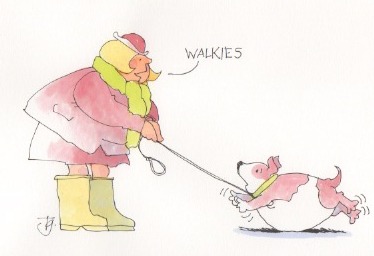DOGS AS EXERCISE MACHINES
One commentator on my first Blog (on high blood pressure) recounted the good effects of dog walking on his own blood pressure. Now his observations have been ratified by two studies reported in Circulation: Cardiovascular Quality and Outcomes.
Dogs and mortality (human mortality that is)
The first study was a meta-analysis (see glossary) of 10 prospective studies including 3.8 million adults1. It found that dog owners had a 24% lower risk for death over 10 years’ follow-up, compared with nonowners. Among those who were known to have coronary problems at the start of the study, mortality risk was 65% lower with dog ownership. This is an example of patient driven cardiac rehabilitation – about which I will have a lot to say in future blogs
The second study looked at the 10 year outcomes for 180,000 Swedish patients following either a heart attack or a stroke2. Again there was a substantial survival benefit for dog owners. For heart attack patients who lived alone the death rate was reduced by 33% if they were dog owners – and by 15% for dog owners living with a partner/child. For stroke patients the figures were reductions of 27% and 5%.
How does that work?
I suppose that there are several mechanisms by which dog ownership might increase life expectancy. Maybe dog owners are healthier to start with, maybe there are psychological benefits which increase lifespan – but for me the most convincing explanation is walkies. Dog ownership confers an obligation to get off the sofa and get out there whatever the weather or state of disinclination. The lessening of the effect for those who have a partner/child is due to the division of labour provided by a larger household.
Should I get a dog?
Well, perhaps. There a few thousand other considerations of course but if you do decide on the canine health protection route here is another one. If you use walking as your preferred exercise, the speed you go matters. A further recent study looking at walking speed and both mental and physical health at the age of 45 produced some startling results. A slow walking pace (less than 2.5 mph or 4 kph) was associated with signs of accelerating aging indicated by such factors as blood pressure, obesity, lung function and brain function. So stride out, don’t dawdle if you want the best out of your dog.
- doi.org/10.1161/CIRCOUTCOMES.119.005554
- doi.org/10.1161/CIRCOUTCOMES.118.005342
Subscribe to the blog
Categories
- Accelerometer
- Alzheimer's disease
- Blood pressure
- BMI
- Cancer
- Complications
- Coronary disease
- Cycling
- Dementia
- Diabetes
- Events
- Evidence
- Exercise promotion
- Frailty
- Healthspan
- Hearty News
- Hypertension
- Ill effects
- Infections
- Lifespan
- Lipids
- Lung disease
- Mental health
- Mental health
- Muscles
- Obesity
- Osteoporosis
- Oxygen uptake
- Parkinson's Disease
- Physical activity
- Physical fitness
- Pregnancy
- Running
- Sedentary behaviour
- Strength training
- Stroke
- Uncategorized
- Walking



Having no dog , only a husband, the speed of walking is dictated by the pace of the slower one. My natural speed is much quicker when walking alone !